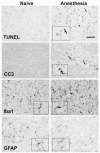Isoflurane Exposure Induces Cell Death, Microglial Activation and Modifies the Expression of Genes Supporting Neurodevelopment and Cognitive Function in the Male Newborn Piglet Brain
- PMID: 27898690
- PMCID: PMC5127656
- DOI: 10.1371/journal.pone.0166784
Isoflurane Exposure Induces Cell Death, Microglial Activation and Modifies the Expression of Genes Supporting Neurodevelopment and Cognitive Function in the Male Newborn Piglet Brain
Abstract
Exposure of the brain to general anesthesia during early infancy may adversely affect its neural and cognitive development. The mechanisms mediating this are complex, incompletely understood and may be sexually dimorphic, but include developmentally inappropriate apoptosis, inflammation and a disruption to cognitively salient gene expression. We investigated the effects of a 6h isoflurane exposure on cell death, microglial activation and gene expression in the male neonatal piglet brain. Piglets (n = 6) were randomised to: (i) naive controls or (ii) 6h isoflurane. Cell death (TUNEL and caspase-3) and microglial activation were recorded in 7 brain regions. Changes in gene expression (microarray and qPCR) were assessed in the cingulate cortex. Electroencephalography (EEG) was recorded throughout. Isoflurane anesthesia induced significant increases in cell death in the cingulate and insular cortices, caudate nucleus, thalamus, putamen, internal capsule, periventricular white matter and hippocampus. Dying cells included both neurons and oligodendrocytes. Significantly, microglial activation was observed in the insula, pyriform, hippocampus, internal capsule, caudate and thalamus. Isoflurane induced significant disruption to the expression of 79 gene transcripts, of these 26 are important for the control of transcription and 23 are important for the mediation of neural plasticity, memory formation and recall. Our observations confirm that isoflurane increases apoptosis and inflammatory responses in the neonatal piglet brain but also suggests novel additional mechanisms by which isoflurane may induce adverse neural and cognitive development by disrupting the expression of genes mediating activity dependent development of neural circuits, the predictive adaptive responses of the brain, memory formation and recall.
Conflict of interest statement
The authors have declared that no competing interests exist.
Figures





References
MeSH terms
Substances
Grants and funding
LinkOut - more resources
Full Text Sources
Other Literature Sources
Research Materials

